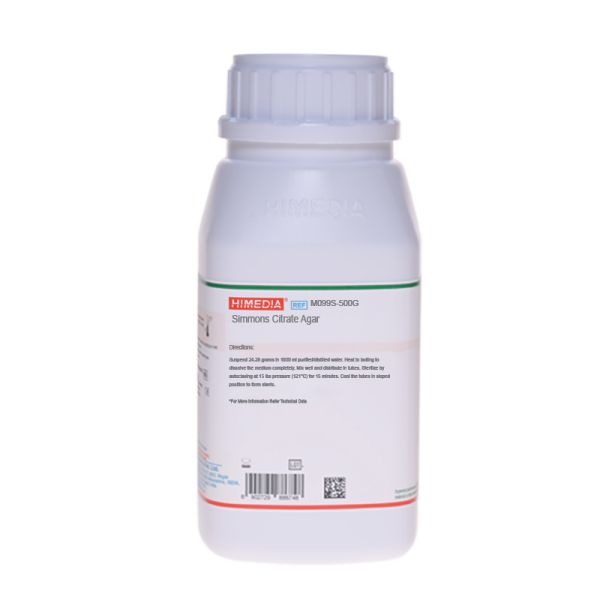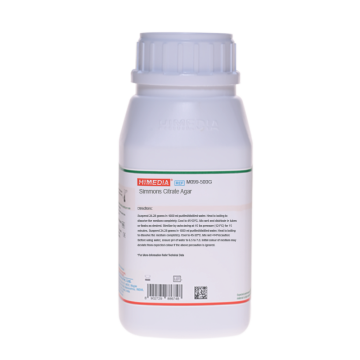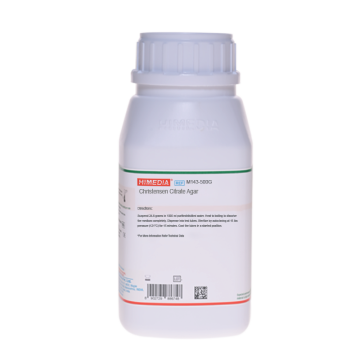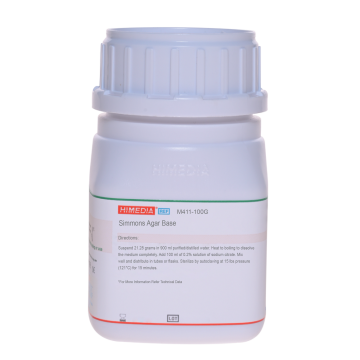 Your enquiry has been submitted
Your enquiry has been submitted
Simmons Citrate Agar
Identification#CC293D
Simmons Citrate Agar is used for differentiation between faecal coli and members of the aerogenes group on the basis of citrate utilization.
Composition**
| Ingredients | Gms / Litre |
|---|---|
| Ammonium dihydrogen phosphate | 1.000 |
| Magnesium sulphate | 0.200 |
| Dipotassium phosphate | 1.000 |
| Sodium citrate | 2.000 |
| Sodium chloride | 5.000 |
| Bromo thymol blue | 0.080 |
| Agar | 15.000 |
Final pH (at 25°C): 6.8±0.1
**Formula adjusted, standardized to suit performance parameters
Directions
Suspend 24.28 grams in 1000 ml distilled water. Heat to boiling to dissolve the medium completely. Mix well and distribute in tubes. Sterilize by autoclaving at 15 lbs pressure (121°C) for 15 minutes. Cool the tubes as slants.
Principle And Interpretation
These media are used for the differentiation between Enterobacteriaceae and the members of aerogenes group on the basis of citrate utilization as sole carbon source. Initially the citrate medium was developed by Koser (1) containing ammonium salt as the only nitrogen source and citrate as the only carbon source for differentiating Escherichia coli and Enterobacter aerogenes by IMViC tests. Later on Simmons (2) modified Kosers formulation by adding agar and bromothymol blue (3). It is recommended by APHA (4). It is also recommended by BIS (5) for isolation of Escherichia coli
Ammonium dihydrogen phosphate and sodium citrate serves as the sole nitrogen and carbon source respectively. Bromo thymol blue is the pH indicator. The organisms produce an alkaline reaction which is indicated by the change in colour from green to blue.
Quality Control
Appearance: Yellow coloured homogeneous free flowing powder
Gelling: Firm, comparable with 1.5% Agar gel
Colour and Clarity of prepared medium: Forest green coloured slightly opalescent gel forms as slants.
Reaction: Reaction of 2.43% w/v aqueous solution at 25°C. pH: 6.8±0.1
pH: 6.70-6.90
Cultural Response
Cultural characteristics observed after an incubation at 35-37°C for 18 - 24 hours.
| Organism | Inoculum (CFU) | Growth | Citrate Utilisation |
|---|---|---|---|
| Enterobacter aerogenes ATCC 13048 | 50-100 | good-luxuriant | Positive reaction, blue colour |
| Escherichia coli ATCC 25922 | 50-100 | inhibited | |
| Salmonella Enteritidis ATCC 13076 | 50-100 | good-luxuriant | Positive reaction, blue colour |
| Salmonella Typhimurium ATCC 14028 | 50-100 | good-luxuriant | Positive reaction, blue colour |
| Salmonella Typhi ATCC 6539 | 50-100 | fair to good | Negative reaction, green colour |
| Shigella dysenteriae ATCC 13313 | 50-100 | inhibited | Negative reaction, green colour |
Storage and Shelf Life
Store below 30°C in tightly closed container the prepared medium at 2 - 8°C. Use before expiry date on the label.
Reference
- Koser, 1923, J. Bact., 8:493.
- Simmons, 1926, J. Infect. Dis., 39:209.
- MacFaddin J., 1985, Media for Isolation-Cultivation-Identification-Maintenance of Medical Bacteria, Vol. 1, Williams and Wilkins, Baltimore.
- American Public Health Association, 1981, Standard Methods for the Examination of Water and Wastewater, 15th ed., APHA Inc., Washington, D.C.
- Bureau of Indian Standards, IS:5887 (Part II) 1976, reaffirmed 1986
| Product Name | Simmons Citrate Agar |
|---|---|
| SKU | M099S |
| Product Type | Regular |
| Physical Form | Powder |
| Origin | Chemically defined (HiCynth™) |
| Packaging type | HDPE |
| References | 1. Koser, 1923, J. Bact., 8:493. 2.Simmons, 1926, J. Infect. Dis., 39:209. 3.MacFaddin J., 1985, Media for Isolation-Cultivation-Identification-Maintenance of Medical Bacteria, Vol. 1, Williams andWilkins, Baltimore. 4.Eaton A. D., Clesceri L. S., Rice E. W., and Greenberg A W., (Eds.), 2005, Standard Methods for the Examination of Waterand Wastewater, 21st Ed., APHA, Washington, D.C. 5.American Public Health Association, Standard Methods for the Examination of Dairy Products, 1978, 14th Ed., WashingtonD.C. 6.Salfinger Y., and Tortorello M.L. Fifth (Ed.), 2015, Compendium of Methods for the Microbiological Examination ofFoods, 5th Ed., American Public Health Association, Washington, D.C. 7.Baird R.B., Eaton A.D., and Rice E.W., (Eds.), 2015, Standard Methods for the Examination of Water andWastewater, 23rd ed., APHA, Washington, D.C. 8.Isenberg, H.D. Clinical Microbiology Procedures Handb0ook. 2nd Edition. 9.Jorgensen,J.H., Pfaller , M.A., Carroll, K.C., Funke, G., Landry, M.L., Richter, S.S and Warnock., D.W. (2015)Manual of Clinical Microbiology, 11th Edition. Vol. 1. 10.Wehr H. M. and Frank J. H., 2004, Standard Methods for the Microbiological Examination of Dairy Products, 17th Ed.,APHA Inc., Washington, D.C. |
| Customized Product Available | No |









